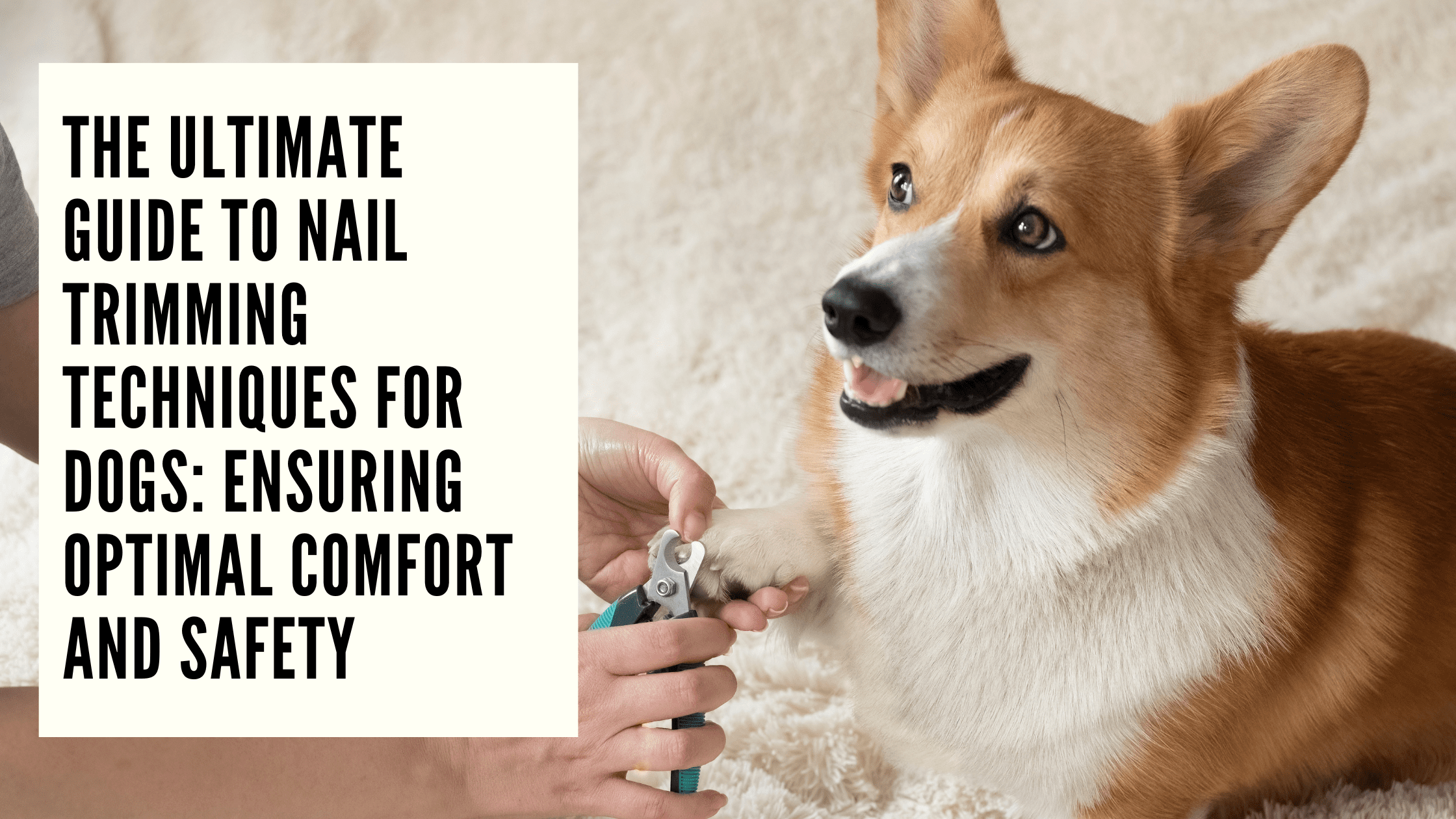The Ultimate Guide to Nail Trimming Techniques for Dogs: Ensuring Optimal Comfort and Safety
Introduction:
Nail trimming is not just a cosmetic procedure for dogs; it’s a fundamental aspect of their grooming routine that directly impacts their well-being. While it’s understandable that many pet owners feel apprehensive about clipping their furry friend’s nails, mastering the proper techniques can turn this task into a stress-free and beneficial experience for both you and your dog. In this extensive guide, we’ll delve deep into the significance of nail care, the intricate anatomy of a dog’s nail, step-by-step trimming methods, advanced techniques for challenging nails, and proactive measures for maintaining optimal comfort throughout the process.
Understanding the Significance of Nail Care:
Nail care goes beyond aesthetics; it’s a critical component of your dog’s overall health and mobility. Dogs’ nails continuously grow, and without regular trimming, they can become overgrown, leading to discomfort, pain, and even mobility issues. Long nails can also curl into the paw pads, causing infections, discomfort, and difficulty walking. By prioritizing nail care, you’re not only ensuring your dog’s comfort but also mitigating potential health problems down the road.
Anatomy of a Dog’s Nail: A Comprehensive Overview
To effectively trim your dog’s nails, it’s crucial to understand the intricate anatomy of a dog’s nail. Each nail comprises several components, each serving a distinct purpose:
- Claw: The hard, outer covering of the nail, primarily composed of keratin.
- Quick: A sensitive area within the nail that contains blood vessels and nerves. The quick appears pinkish in color and supplies blood to the nail.
- Cuticle: A thin layer of skin that surrounds the base of the nail, providing protection and support.
Identifying the quick is pivotal, as cutting into it can lead to bleeding and discomfort for your dog. Dark-colored nails can pose a challenge, as the quick may be less visible. However, with practice and proper lighting, you can confidently navigate this aspect of nail trimming.
Step-by-Step Nail Trimming Techniques:
- Create a Calm Environment: Choose a quiet, well-lit area for nail trimming. Minimize distractions and ensure your dog feels relaxed.
- Introduce Handling Gradually: Familiarize your dog with the nail trimming process by gently touching their paws and handling the clippers. Offer treats and praise to reinforce positive associations.
- Select the Right Tools: Invest in high-quality nail clippers appropriate for your dog’s size and nail thickness. Guillotine-style clippers are suitable for small to medium-sized dogs, while scissor-style clippers are preferable for larger breeds.
Positioning and Technique:
- Hold your dog’s paw firmly yet gently, ensuring they feel secure.
- Examine the nail under a bright light to identify the quick. If uncertain, err on the side of caution and trim smaller portions.
- Position the clippers perpendicular to the nail, cutting just above the quick at a 45-degree angle.
- Trim a small portion of the nail at a time, focusing on maintaining a smooth, even edge.
- Use a nail file to smooth any rough edges and achieve the desired length.
Advanced Techniques for Challenging Nails:
- Grinding vs. Clipping: Some dogs may be more comfortable with nail grinding, as it minimizes the risk of cutting into the quick. Invest in a high-quality nail grinder and gradually introduce it to your dog to ensure they feel comfortable with the sensation.
- Managing Dark Nails: Dark-colored nails can make it challenging to identify the quick. Shine a flashlight through the nail to illuminate the quick, making it easier to determine where to trim. Alternatively, trim small portions of the nail at a time until you reach the desired length.
- Addressing Overgrown Nails: If your dog’s nails are significantly overgrown, gradual trimming may be necessary to avoid cutting into the quick. Trim small portions of the nail every few days until you reach the appropriate length, rewarding your dog for their patience and cooperation.
Proactive Measures for Maintaining Comfort:
- Regular Maintenance: Establish a consistent nail trimming schedule, aiming to trim your dog’s nails every 2-4 weeks. Consistency is key to preventing overgrowth and maintaining optimal nail health.
- Monitor Your Dog’s Health: Keep an eye on your dog’s nails for signs of overgrowth, curling, or discomfort. Regularly inspect their paws and consult your veterinarian if you notice any abnormalities.
- Provide Positive Reinforcement: Make nail trimming a positive and rewarding experience for your dog by offering treats, praise, and affection. Positive reinforcement strengthens the bond between you and your furry companion, fostering trust and cooperation.
- Consider Professional Assistance: If you’re uncomfortable trimming your dog’s nails or if your dog exhibits extreme anxiety or aggression during the process, seek assistance from a professional groomer or veterinarian. They can offer expert guidance and ensure your dog’s nails are trimmed safely and effectively.
Conclusion:
Nail trimming is an essential aspect of dog grooming that requires patience, practice, and a thorough understanding of your dog’s anatomy and behavior. By following the comprehensive techniques outlined in this guide and prioritizing your dog’s comfort and safety, you can confidently tackle nail care and contribute to your furry friend’s overall well-being. Remember, nail trimming is not just a chore—it’s an opportunity to bond with your dog and demonstrate your commitment to their health and happiness. With dedication and diligence, you can master the art of nail trimming and ensure your dog enjoys a lifetime of comfort and mobility.
You May Also Like : Tools for Dog Grooming
FAQs
1. How often should I trim my dog’s nails?
It’s generally recommended to trim your dog’s nails every 2-4 weeks, although the frequency may vary depending on factors such as your dog’s activity level and the rate of nail growth. Regular trimming helps prevent overgrowth, discomfort, and potential health issues associated with long nails.
2. How do I know if I’ve cut my dog’s nails too short?
Cutting into the quick, the sensitive area within the nail containing blood vessels and nerves, can cause bleeding and discomfort for your dog. Signs that you’ve cut the nails too short include bleeding, vocalization, and reluctance to bear weight on the affected paw. If you accidentally trim the nails too short, apply styptic powder to stop the bleeding and provide comfort to your dog.
3. My dog has dark-colored nails. How can I identify the quick?
Identifying the quick in dark-colored nails can be challenging. Shine a flashlight through the nail to illuminate the quick, making it easier to determine where to trim. Alternatively, trim small portions of the nail at a time until you reach the desired length, erring on the side of caution to avoid cutting into the quick.
4. My dog is anxious during nail trimming. How can I help them relax?
Create a calm and comfortable environment for nail trimming, minimizing distractions and offering treats and praise to reinforce positive associations. Gradually introduce your dog to the nail trimming process, starting with gentle paw handling and progressing to trimming. If your dog exhibits extreme anxiety or aggression, consider seeking professional assistance from a groomer or veterinarian.
5. What if my dog’s nails are overgrown?
If your dog’s nails are significantly overgrown, gradual trimming may be necessary to avoid cutting into the quick. Trim small portions of the nail every few days until you reach the appropriate length, rewarding your dog for their patience and cooperation. Additionally, consult your veterinarian for guidance on managing overgrown nails and ensuring your dog’s comfort and well-being.

